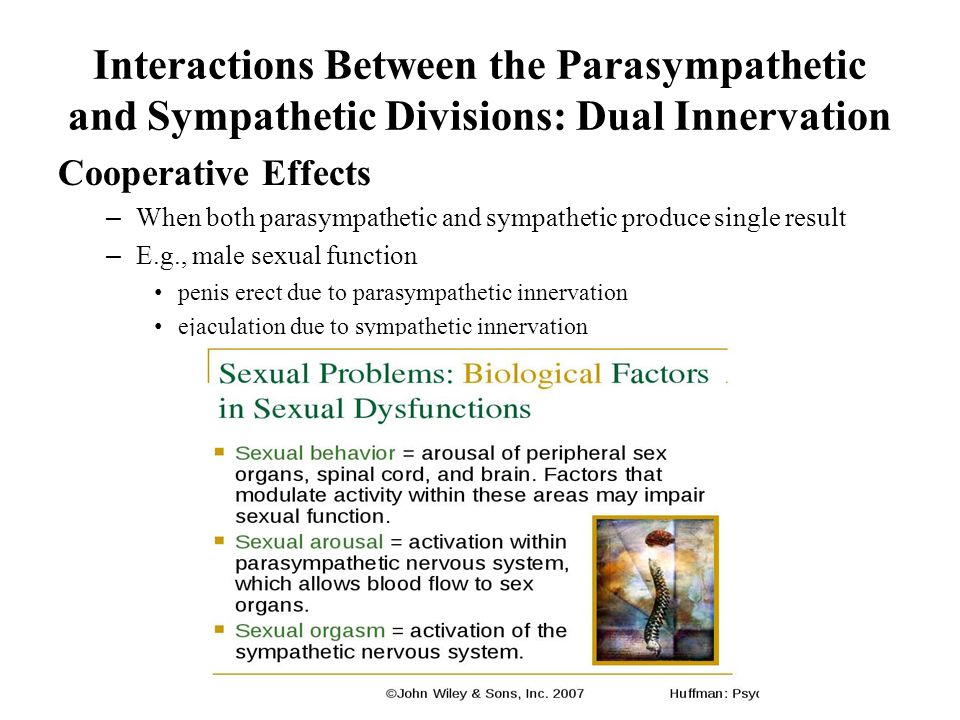The Activation Of The Sympathetic Nervous System Results In

Start studying Chapter 9 Physiology: The Autonomic Nervous System. Activation of sympathetic system prepares the. Always result from activation of. The sympathetic nervous system. This occurs as a result of activation of alpha-1 adrenergic receptors by norepinephrine released by post-ganglionic sympathetic. Functions of the Parasympathetic Nervous System Activation of the parasympathetic division of the auto-nomic nervous system results in conservation and restoration of.
Which of the following statements about the autonomic nervous system is (are) INCORRECT? Loss of all conscious brain activity is not life threatening if food and water are provided, because the autonomic nervous system maintains all needed body functions. Heart rate and blood pressure are increased under parasympathetic stimulation.

The parasympathetic division is also called the craniosacral division. The sympathetic and parasympathetic functions most often produce opposing effects on a system or organ. The sympathetic division has short preganglionic fibers.
The activity of the sympathetic nervous system is of importance to manual therapists, since the experience of pain is associated with sympathetic activity. There has been little exploration into the effects of mobilizing vertebral segments below the cervical spine. In addition to this, a synthesis of the evidence for changes in sympathetic outcome measures has not been completed.
The primary aim of this review was to investigate the effects of spinal mobilizations compared to a control or placebo on sympathetic outcome measures. Free Aeg Cafamosa Cf 100 User Manual Programs on this page. The secondary aim was to establish the level of change, either excitatory or inhibitory, in sympathetic outcome measures. Five electronic databases (Ovid Medline, Embase, AMED, PEDro, and the Cochrane library; from database inception to May 2012) were searched for randomized controlled trials.
Two independent raters applied inclusion criteria and rated studies for methodological quality. Seven studies met the inclusion criteria. All studies demonstrated a consistent increase in sympathetic outcome measures, indicative of sympathetic excitation, irrespective of the segments mobilized.
Synthesis of the results established strong evidence (multiple high-quality randomised controlled trials (RCTs) for a positive change in skin conductance, respiratory rate, blood pressure, and heart rate among the healthy population. As only one study investigated changes in a symptomatic population, there was limited evidence (one RCT) for an increase in skin conductance and decrease in skin temperature. Evidence from this systematic review supports a sympatho-excitatory response to spinal mobilizations irrespective of the segment mobilized. Database of Abstracts of Reviews of Effects (DARE): Quality-assessed Reviews [Internet] - Centre for Reviews and Dissemination (UK). Local anaesthetic sympathetic blockade (LASB) is a common treatment for complex regional pain syndrome (CRPS).
It involves blocking the activity of sympathetic nerves alongside the spine. The sympathetic nervous system mainly controls unconscious actions such as heart rate, blood flow, and perspiration. The injection of a local anaesthetic drug around the nerves temporarily blocks the function of the nerves. This updated review aimed to summarise the available evidence regarding whether LASB is effective at reducing pain in CRPS, how long any pain relief might last, and whether LASB is safe. Cochrane Database of Systematic Reviews: Plain Language Summaries [Internet] - John Wiley & Sons, Ltd. Segmental neurological modulation, neural hysteresis and biomechanical effects have been proposed as mechanisms underpinning the effects of manual therapy.
An increasing number of studies hypothesise activation of the central nervous system resulting in a non-segmental hypoalgesic effect with concurrent activation of other neural pathways as a potential mechanism of action. Whether this model is consistent with the current literature is unknown. This systematic review aims to assess the consistency of evidence supporting an involvement of supraspinal systems in mediating the effects of passive cervical joint mobilisation. Lm-m266a-svlp Manual here.